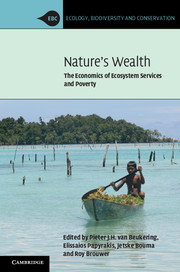Book contents
- Frontmatter
- Contents
- List of contributors
- Acknowledgements
- 1 The economics of ecosystem services and poverty
- Part I Biodiversity-related ecosystem services
- Part II Marine-related ecosystem services
- Part III Forest-related ecosystem services
- 8 Greening the charcoal chain in Tanzania
- 9 Payments for environmental services in the protected areas of the Philippines
- 10 The copper curse and forest degradation in Zambia
- 11 Institutions and forest management in the Swat region of Pakistan
- Part IV Water-related ecosystem services
- Part V Land-related ecosystem services
- Index
- References
8 - Greening the charcoal chain in Tanzania
Published online by Cambridge University Press: 05 July 2013
- Frontmatter
- Contents
- List of contributors
- Acknowledgements
- 1 The economics of ecosystem services and poverty
- Part I Biodiversity-related ecosystem services
- Part II Marine-related ecosystem services
- Part III Forest-related ecosystem services
- 8 Greening the charcoal chain in Tanzania
- 9 Payments for environmental services in the protected areas of the Philippines
- 10 The copper curse and forest degradation in Zambia
- 11 Institutions and forest management in the Swat region of Pakistan
- Part IV Water-related ecosystem services
- Part V Land-related ecosystem services
- Index
- References
Summary
Introduction
With a population of 34 million and an extremely high reliance on charcoal, Tanzania is a classic example of the social and environmental risks faced by many developing countries. About 85% of the total urban population uses charcoal for household cooking and energy provision for small and medium enterprises (Sawe 2004). In 1992 the total amount of charcoal consumed nationwide was estimated to be about 1.2 million tons (Sawe 2004). In 2002, the charcoal business generated revenues of more than 200 billion TShs (US$ 200 million), with more than 70 000 people from rural and urban areas employed in the industry (TaTEDO 2002b). Dar es Salaam, Tanzania’s largest city, accounts for more than 50% of all charcoal consumed in the country.
The charcoal sector is far from sustainable. The forest resources that the industry is relying on are disappearing rapidly and the productivity of the sector has not seen any improvement either. The charcoal sector in Tanzania is operating economically, socially and environmentally in a suboptimal manner. However, solutions that safeguard the charcoal sector’s future are not straightforward.
- Type
- Chapter
- Information
- Nature's WealthThe Economics of Ecosystem Services and Poverty, pp. 183 - 200Publisher: Cambridge University PressPrint publication year: 2013
References
- 1
- Cited by



